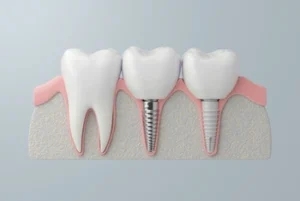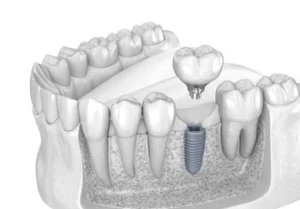Dental implants are one of the most reliable and natural-looking treatments to replace missing teeth, offering long-term benefits for oral function and aesthetics. However, like any surgical procedure, it’s normal to experience some level of discomfort during the healing process. If you’re wondering how to relieve pain from dental implant treatment and make your recovery smoother, you’re not alone. Most patients report mild discomfort rather than severe pain, and with the right care, recovery is typically quick and straightforward.
This guide explains why dental implant pain occurs, what to expect after surgery, and effective techniques to reduce discomfort and support healing.
Understanding Dental Implant Pain and Why It Happens
During a dental implant procedure, a titanium post is surgically placed into the jawbone to function as an artificial tooth root. As healing progresses, the implant bonds with the surrounding bone, forming a secure base for a dental crown or bridge. While this treatment offers a long-lasting solution for missing teeth, it’s still a minor surgical procedure, and some pain is part of the natural healing process.
Why Pain Occurs After Implant Surgery
There are several reasons why you might feel pain or discomfort around the implant site:
- Tissue response: Your gums and jawbone need time to heal after the procedure, leading to mild swelling, tenderness, or a dull ache.
- Inflammation: Localised inflammation is common as the body begins repairing tissues around the implant area.
- Pressure from placement: The surgical process involves drilling into the jawbone, which can cause temporary sensitivity and discomfort.
- Bone and nerve involvement: In rare cases, nerve damage or pressure on surrounding bone and tissues may lead to prolonged pain.
In most cases, this discomfort is temporary and manageable with proper aftercare.
What the Healing Process Usually Looks Like
The recovery timeline is predictable for most patients. Discomfort typically reaches its highest point within the first 24 to 48 hours after dental implant surgery and then steadily lessens in the following days.
- Day 1–3: You may experience swelling, minor bleeding, and mild discomfort around the implant site. Several hours after the procedure, the effects of the local anaesthetic will fade, and you may start to feel a dull ache.
- Day 4–7: Swelling usually begins to subside, and discomfort is generally mild or barely noticeable by the end of the first week.
- Week 2 and beyond: Most patients report little to no pain as the implant integrates with the jawbone. Persistent pain beyond this point should be checked by your dentist.
If pain worsens or doesn’t improve after a week, it could indicate complications such as infection or implant failure, and professional advice is essential.
Effective Ways to Relieve Pain After Dental Implant Surgery
Pain relief after a dental implant is usually straightforward. You can minimise discomfort and support a smooth recovery with proper care and a few simple techniques.
1. Use Painkillers as Recommended
Non-prescription painkillers like paracetamol or ibuprofen are often effective for easing discomfort and reducing inflammation. If needed, your dentist might recommend stronger medication. Be sure to follow the recommended dosage and seek your dentist’s advice before taking multiple medications together.
2. Apply Ice Packs to Reduce Swelling
Placing an ice pack on the outside of your cheek close to the implant site can help minimise swelling and provide pain-numbing relief. Use the ice for 15–20 minutes at a time, with breaks in between, during the first 24 hours after surgery.
3. Stick to Soft Foods During Recovery
Eating soft foods such as soups, mashed vegetables, yoghurt, or scrambled eggs helps protect the implant site and prevent irritation. Avoid hard foods, crunchy snacks, or anything that requires excessive chewing while healing your gums.
4. Maintain Excellent Oral Hygiene
Keeping your mouth clean is necessary to prevent infection and support healing. Gently brush your teeth, avoiding direct contact with the implant site for the first few days. Your dentist may recommend a saltwater rinse or an antibacterial mouthwash to keep the area clean without disturbing the healing tissues.
5. Avoid Smoking and Alcohol
Smoking may slow down healing and raise the potential of implant failure by reducing blood flow to the gums and jawbone. Similarly, alcohol can irritate the tissues and interfere with any antibiotics prescribed. Avoid both during the initial recovery period for the most effective outcome.
6. Follow All Post-Operative Advice
Your dentist will provide specific instructions for post-surgery care, including how to brush, when to eat, and what signs to watch for. Carefully adhering to these instructions is one of the most effective ways to support a smooth recovery and keep discomfort to a minimum.
When Pain Might Signal a Problem
While most dental implant pain is mild and short-lived, there are situations where discomfort may indicate an underlying issue. Contact your dentist if you notice:
- Persistent pain lasting more than two weeks
- Increasing swelling, redness, or warmth around the implant site
- Ongoing bleeding or pus discharge
- A loose or unstable implant
- Numbness, tingling, or severe shooting pain (possible nerve damage)
Early treatment of complications like infection or implant failure can often prevent further issues and help save the implant.
How Your Dentist Can Help Manage Pain
If home remedies and over-the-counter solutions are not enough, your dentist may offer additional treatments. These can include prescribing antibiotics for infection, adjusting the implant if it’s placing pressure on surrounding tissues, or performing minor procedures to promote healing. Sedation options may also be available for patients with severe discomfort or anxiety during the treatment process.
The Long-Term Benefits Make It Worthwhile
Although some pain and discomfort are expected early after dental implant surgery, the long-term benefits far outweigh the temporary inconvenience. Dental implants provide a natural-looking, permanent solution for missing teeth, restoring chewing function, protecting the jawbone from deterioration, and supporting overall oral health. After healing is complete, most patients hardly notice their tooth implant at all, as it looks, feels, and functions like a natural tooth.
Final Thoughts: A Smooth Recovery Is Within Reach

If you have any concerns about your recovery or the level of pain you’re experiencing, don’t hesitate to contact Balmoral Dental Care at (07) 3113 9789 to book your appointment. Prompt professional advice ensures any complications are treated early, helping you enjoy the full benefits of your new smile with confidence.
Note: Any surgical or invasive procedure carries risks. Before proceeding, you should seek a second opinion from an appropriately qualified health practitioner.
References
Colgate. (n.d.). What is good oral hygiene? Retrieved from https://www.colgate.com/en-us/oral-health/adult-oral-care/what-is-good-oral-hygiene
Cleveland Clinic. (n.d.). Does it matter what type of ice pack you use for an injury? Retrieved from https://health.clevelandclinic.org/does-it-matter-what-type-of-ice-pack-you-use-for-an-injury
Mayo Clinic Staff. (n.d.). Dental implant surgery: What you can expect. Retrieved from https://www.mayoclinic.org/tests-procedures/dental-implant-surgery/about/pac-20384622



